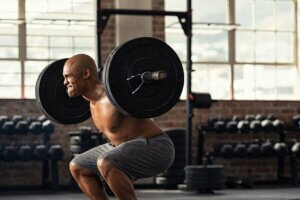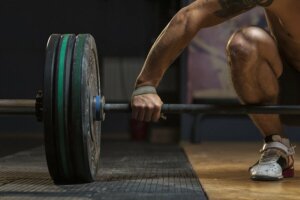Important Rules for Weightlifting Competitions

Weightlifting is one of the most popular sports in the Olympic Games, year after year. The goal is for each competitor to lift the largest amount of weight possible. While the sport may seem straight-forward, some may wonder what the rules for weightlifting are. In this article, we’ll explore this information.
The most important rules of weightlifting
Just like any other sport, weightlifting has very specific rules that each of its competitors must follow. If they don’t, there are different levels of penalties.
This system of rules has been developed in an attempt to ensure -as much as possible- the safety and wellbeing of each of the participants. The system tries to ensure that the competition is completely clean and transparent, leaving nothing up to interpretation.
The first aspect of weightlifting to consider is that the competition is always divided according to gender and the target lifting weight. This rule isn’t waived under any circumstances.
Following these restrictions, in the female category, it’s possible to participate in the following weight categories (in kilograms): 48, 53, 58, 63, 69, 75, and 75+. On the other hand, the male category is divided into the following weight categories (in kilograms): 56, 62, 69, 77, 85, 94, 105, and 105+.
When it’s actually time to lift their weights, each competitor has three attempts. If they successfully lift all of their weight on the first try, they can request for more weight to be added. Specifically, one additional kilogram for the second try and one additional kilogram for the third and final try.

It’s worth noting that it’s not mandatory to request extra weight. The competitor can repeat the same amount of weight for each of their three attempts, although of course, this isn’t recommended. These regulations are the same for both men and women.
Following the lifting process, each athlete is given a ten minute rest period. After this rest period, they’ll begin the same process a second time. The final score of each competitor is composed of the total sum from the two different weights.
Other rules to keep in mind
In addition to the previously mentioned rules, there are others that are important in this sport:
- The lifts must be continuous, without any type of pause.
- The competitor cannot leave the platform at any time.
- Except for the soles of the shoes, no other part of the body can touch the floor.
- The elbows cannot touch any part of the body.
- The athlete has one minute from the moment they’re called to the platform.
Important aspects of weightlifting
All of the previously mentioned rules are the most important in the sport, especially when we’re talking about the actual competition. However, there are other important aspects to keep in mind that every athlete needs to know.

One such important caveat is if one of the athletes has a deformity and can’t lift their arms well. In this case, it’s absolutely necessary that they communicate such a problem to the judges.
After each lift, the competitors have ten minutes to rest. It’s also important to remember that although their position doesn’t have to be perfect, the athlete’s feet must be parallel and well-aligned.
The winner is, simply put, the competitor who manages to lift more weight than anyone else. But, what happens if there’s a technical tie? In the case of a tie, the winner is the competitor who weighed the least during the pre-competition weighing process.
There are other rules which are admittedly less important, such as the fact that the competitor’s uniform can’t touch their knees. Even with rules like these, it’s recommended to know and respect the norms of the sport in order to avoid sanctions and problems.
This system of rules for weightlifting is developed so that the competitions can be fair and so that there isn’t any shadow of a doubt about the competitors and winners. Their objective is to avoid issues, sanctions, and disqualifications. This is especially important considering the effort that athletes put into this sport.
Weightlifting is one of the most popular sports in the Olympic Games, year after year. The goal is for each competitor to lift the largest amount of weight possible. While the sport may seem straight-forward, some may wonder what the rules for weightlifting are. In this article, we’ll explore this information.
The most important rules of weightlifting
Just like any other sport, weightlifting has very specific rules that each of its competitors must follow. If they don’t, there are different levels of penalties.
This system of rules has been developed in an attempt to ensure -as much as possible- the safety and wellbeing of each of the participants. The system tries to ensure that the competition is completely clean and transparent, leaving nothing up to interpretation.
The first aspect of weightlifting to consider is that the competition is always divided according to gender and the target lifting weight. This rule isn’t waived under any circumstances.
Following these restrictions, in the female category, it’s possible to participate in the following weight categories (in kilograms): 48, 53, 58, 63, 69, 75, and 75+. On the other hand, the male category is divided into the following weight categories (in kilograms): 56, 62, 69, 77, 85, 94, 105, and 105+.
When it’s actually time to lift their weights, each competitor has three attempts. If they successfully lift all of their weight on the first try, they can request for more weight to be added. Specifically, one additional kilogram for the second try and one additional kilogram for the third and final try.

It’s worth noting that it’s not mandatory to request extra weight. The competitor can repeat the same amount of weight for each of their three attempts, although of course, this isn’t recommended. These regulations are the same for both men and women.
Following the lifting process, each athlete is given a ten minute rest period. After this rest period, they’ll begin the same process a second time. The final score of each competitor is composed of the total sum from the two different weights.
Other rules to keep in mind
In addition to the previously mentioned rules, there are others that are important in this sport:
- The lifts must be continuous, without any type of pause.
- The competitor cannot leave the platform at any time.
- Except for the soles of the shoes, no other part of the body can touch the floor.
- The elbows cannot touch any part of the body.
- The athlete has one minute from the moment they’re called to the platform.
Important aspects of weightlifting
All of the previously mentioned rules are the most important in the sport, especially when we’re talking about the actual competition. However, there are other important aspects to keep in mind that every athlete needs to know.

One such important caveat is if one of the athletes has a deformity and can’t lift their arms well. In this case, it’s absolutely necessary that they communicate such a problem to the judges.
After each lift, the competitors have ten minutes to rest. It’s also important to remember that although their position doesn’t have to be perfect, the athlete’s feet must be parallel and well-aligned.
The winner is, simply put, the competitor who manages to lift more weight than anyone else. But, what happens if there’s a technical tie? In the case of a tie, the winner is the competitor who weighed the least during the pre-competition weighing process.
There are other rules which are admittedly less important, such as the fact that the competitor’s uniform can’t touch their knees. Even with rules like these, it’s recommended to know and respect the norms of the sport in order to avoid sanctions and problems.
This system of rules for weightlifting is developed so that the competitions can be fair and so that there isn’t any shadow of a doubt about the competitors and winners. Their objective is to avoid issues, sanctions, and disqualifications. This is especially important considering the effort that athletes put into this sport.
All cited sources were thoroughly reviewed by our team to ensure their quality, reliability, currency, and validity. The bibliography of this article was considered reliable and of academic or scientific accuracy.
- Ministerio de cultura y deporte. HALTEROFILIA, REGLAMENTO TÉCNICO CEU 2020. Extraído de: https://www.csd.gob.es/sites/default/files/media/files/2019-12/RT%202020%20HALTEROFILIA.pdf
- REGLAMENTOS PARA LOS CAMPEONATOS DE ESPAÑA 2018 – 2020. Extraído de: http://www.afedegi.com/halterofilia/pdf/competicion/halterofilia/2018222_123554_REGL%20CTS%20ESP.2018-2020-DEFINITIVO-definitivo%20-2-2018.pdf
This text is provided for informational purposes only and does not replace consultation with a professional. If in doubt, consult your specialist.








